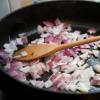Frozen foods: myths and truth. Homemade semi-finished products: cook, freeze, reheat
The phrase “Cook once, eat a month” spread all over the world, and the frozen food system itself became very popular in the West. Who wouldn't love the idea of preparing a week's or a month's worth of food in just one day?
What do you associate with frozen food? Probably with semi-finished products, all kinds of dumplings and mixed vegetables from the supermarket. But what if I told you that the frozen food system makes life easier for housewives and allows them to free themselves from cooking for 2 weeks or a month. It's very simple: you can prepare food for the whole family for a whole week in one day! To do this, you just need to prepare a large number of dishes and... freeze them!
In our countries, not every housewife can boast of a separate freezer or a two-door refrigerator with a large freezer. Therefore, cooking for a month is not suitable for everyone. But cooking for 2 weeks (considering that most housewives at home have a refrigerator with three freezer compartments) is ideal. But don’t be sad for those who have a one-compartment freezer. A small freezer, if stored compactly, will provide seven ready-made meals for a week.
Advantages of cooking for a week - a month
- You will have more free time. Spend it with your family and dedicate it to yourself. Now you definitely won’t be able to look for excuses for your laziness and will finally take care of your figure. This will help you.
- You can save your family budget. American women have calculated that on average they save about $250 when purchasing groceries for a month. No wonder. In addition, you can purchase products in large quantities. And with the help of promotions in supermarkets, you can sometimes save a lot of money (for example, using the “every third item is free” scheme).
- You will always be ready for the arrival of guests. Do you often have unexpected guests? Convulsive rushing around the shops and kitchen... Why do you need this? Having fallen in love with cooking for 2 weeks, a month, you will be able to prepare for the arrival of guests (dress beautifully and do makeup). Let your friends figure out for themselves why there are so many goodies on the table!

How not to die in the kitchen in one day while preparing 15-20 dishes?
Determine your cooking modeIt is extremely important that you take time to rest 2-3 times a day. For example, prepare 5-6 dishes early in the morning and then rest for half an hour to an hour. After lunch cooking, take a long rest for several hours. The first time I tried the system mode, I fell asleep in the evening for 3 hours. You can do the same so that you have some strength left for the evening. The cooking process is just as important to plan as it is.
Enlist the support of loved onesIt is ideal if your husband helps you in the cooking process, but this option is more an exception than a common occurrence. Ask him to take care of the children for the day while you provide the family with delicious and nutritious meals. You can hint to him that, having a supply of ready-made dishes, you will have more time not only for yourself and your children, but also for your loved one. And if the husband can help with the rough work (washing, cleaning) - this is already a big plus. The main thing is motivation!
Create a menuIf you've never done menu planning, start learning its principles. Without a competent menu, you will not be able to buy food in the required quantity and provide your family with a variety of dishes. If you don’t know how much food your family eats per month, then it’s too early for you to start cooking for 2 weeks!
For 2-3 weeks, write down everything you cook and how many days you eat it. For example, knowing that a pot of soup does not stay in the refrigerator for more than three days, and a fish casserole has to be thrown away after 2 days, it will be easier for you. 
Based on your family's standard diet, choose recipes to cook. It's good for your wallet to check the promotions in supermarkets. For example, if you love liver and the nearest shopping center has a 50% discount on it, you need to take it. The liver can be used to make liver cutlets, pates, or simply stewed in sour cream. Choose recipes where the active cooking time is no more than half an hour. Of course, consider the tastes of your loved ones.
Buy groceriesA day or two before the planned kitchen “marathon”, go to the supermarket or market. Definitely with your husband, because you will need his strong strong hands. Make a grocery list in advance. It is important to think through everything to the smallest detail. Don't forget how you can
Check your kitchen cabinet for spices! It’s very unpleasant when you have to stop cooking and rush headlong to the nearest store for allspice or vanilla sugar.
Write out a step-by-step action plan for yourselfBe sure to create a cooking plan that you will follow. For example, wash and peel vegetables, add broth, etc. This will allow you not to get lost in the kitchen among a large number of products. 
Important points
None of the frozen foods become poisonous. Its taste or consistency may simply change. That's why It's better not to freeze:
- potatoes in pieces (but in dumplings and potato cutlets - ideal)
- coarsely chopped cabbage (can be used in the form of lazy cabbage rolls)
- sour cream and kefir
- “water” vegetables (for example, cucumbers)
Advice! It is best to freeze meals in portions so that you do not have to refreeze them later if the contents of the container are not eaten.
What you need for freezing- free freezer
- food containers, pickle buckets
- cling film to wrap each container in several layers
- baking paper
- freezer bags
To simplify the preparatory cooking process, a blender or food processor will not hurt you. Makes it easier to cook for 2 weeks and have a multicooker. I make do with a lot of pots.
How to defrost
It is better to defrost prepared food in the refrigerator. I leave it in the refrigerator overnight and then reheat it in the oven. You can also use the microwave. 
I have been freezing the following homemade semi-finished products for a long time:
- cutlets (including potato ones);
- chops and meatballs, meatballs;
- stuffed peppers;
- broths (I cook chicken and fish broths in several pans, and then freeze them in portions: for soups, sauces);
- dough for pizza, pies
At first I doubted it, thinking that there was no benefit left in dishes after freezing, but after studying the information on the topic, I realized that this was far from the case. And if your refrigerator has a blast freezing function, that’s just great. I love the fact that cooking for several weeks allows me to spend more time with my family, have family picnics, and be creative. Prepare for the week and make your life easier! 
Preparing food for several days (video)
A modern woman must manage everything: build a career, take care of children, look like she’s on the cover, run a household, and be a gentle wife. How can you manage all this and not lose your health?
Fortunately, women these days have dozens of au pairs. Washing machine and dishwasher, multicookers, toasters and yogurt makers, bread makers and blenders. And yet, from time to time, everyone is faced with the fact that it is almost midnight, you have to get up at six in the morning, and the next day’s dinner is not ready. And there is no strength to fry cutlets or wrap meat in foil. As a result, the husband and children cook their own pasta and sausages. Where is the way out?
How to make housekeeping easier
But there is a way out. Having stuffed our kitchen with ultra-modern household appliances, we completely forgot about the banal freezer. No, of course, it most often contains a piece of meat or fish, but while you defrost it, while you cook it... Whereas there is a simple and profitable option - to freeze ready-made dishes.
You can freeze almost any food that takes more than half an hour to prepare. Of course, there is no point in freezing rice and buckwheat porridge, but there is a dozen cutlets, stuffed peppers, steaks, baked fish and much more. How to do it right?
Where to begin
You should start by making a grocery list for going to the supermarket. When planning to buy two kilograms of trout, enter twice that amount on the list. The same will apply to any product for the main course - meat, fish or poultry.
Shopping for the house, and the day off is dedicated to making the home comfortable and preparing food for the next few days. When you cook the fish, don’t be lazy to make a few extra servings. Anyway, your hands are already dirty, you have to wash the dishes, but the pot or pan is just hot. Set aside the amount you did not plan to eat in the following days. These pieces will become your strategic reserve.
When cooking broth for soup, the rule is the same: cook twice as much. It won’t go to waste, but it will save a hungry family when you are tired.

What can you freeze?
Anything. Broth, cutlets, stew, cabbage rolls, stuffed peppers, pilaf, fish and meat steaks, boiled poultry and any other dishes that are considered staple in your family.
What to freeze in
There are several options for packaging main dishes. These can be plastic bags of different sizes, cling film, foil, thermal paper (baking paper), plastic containers. Choose what is most convenient for you. The main rule: each piece has its own container. This way, your household won’t have to worry about the portion size.
How long can frozen food be stored?
If your freezer is at the correct temperature (no higher than −5°C), then you can store frozen ready-made meals for 3-4 months.
What are the benefits of freezing prepared foods?
Imagine stashing several portions of a main dish in the freezer for weeks. Now imagine what your evening will look like when you don’t have dinner ready in the refrigerator, and your husband and children start walking in circles asking when we’ll eat. At this moment, throwing a glass of rice into a pan of boiling water and lazily chopping a salad of fresh vegetables, you say: “Salmon with cream sauce, steamed cutlets, beef stroganoff, empanadas, pork chop, liver... Who wants what?”
Made an impression? Still would! Not only do you not have to rack your brains for a filling meal, but you also have the same choice as in a restaurant. And you just need to take the dishes ordered by your family out of the freezer and heat them in a slow cooker, on the stove or in the microwave. And the wolves are fed, and you can relax, and not labor in the kitchen.
Proper packaging is the solution to all problems. By using the right packaging, you will extend the shelf life of your food in the freezer and preserve its taste.
To store frozen foods you can use:
- special bags for freezing with or without a zipper (slider bags);
- plastic containers that can withstand sub-zero temperatures and are suitable for the microwave;

- thick foil;
- cling film;
- disposable baking dishes.
Be sure to label everything you put in the freezer. otherwise, later you simply won’t remember what you froze; frozen foods look completely different. Also sign the freezing date to avoid unpleasant consequences. You can use a permanent marker for this. Regular markers or pens are not suitable for this, as they fade.
What foods can be frozen?
Believe it or not, you can freeze almost all ready-made dishes.

Below are just a few of the dishes that store well in the freezer:
- broths;
- puree soups;
- sausages;
- meat goulash;
- pilaf;
- chops;
- lasagna;
- pates (meat, fish, liver);
- mashed potatoes;
- cereals;
- pasta (boil until al dente);
- cutlets;
- cabbage rolls;
- baked goods (pies, pizza, buns, muffins, pancakes, pancakes);
- casseroles;
- sauces (Bolognese, pesto).
Nuances:
If you cook a lot at once, then do not freeze everything in one package, Divide into portions so you don't have to defrost several times.

The faster the freezing, the better. Many modern freezers have a quick freeze function. To freeze a dish, use this function, and for storage you can use a regular compartment with a standard -18 degrees.
When freezing in bags, try to “expel” all the air, then the products will better retain their appearance and taste.
Do not fill storage containers to the top, since most products contain water, which expands when frozen. This especially applies to broths, soups and gravies.
When storing in the freezer, try to use different shelves for meat and fish dishes, vegetables and other products to protect products from foreign odors.
It is better to add mayonnaise, yogurt, cream to the dish before eating, because after freezing they separate.
How to organize?
1. Make a menu and a list of necessary products. We wrote about this.
2. Plan your work. Start by making a list of what you need to prepare for each recipe. For example: chop and fry one onion, boil the pasta, boil the meat. Then group the same steps: for example, one recipe calls for one onion, and another calls for two, so we can peel and fry three onions. When planning, consider the following: first prepare all the products (clean, wash, cut), then grate, cut, chop, and only then begin to fry, boil, bake. This approach will allow you to cook several dishes at the same time.
3. Prepare all necessary utensils and supplies- knives, cups, pots, pans - and feel free to start cooking, following the work plan.
4. Once all the ingredients are ready, All we have to do is put everything into bags, containers and label it, then put it in the freezer.
Freezing is a great way to store food. But such food can be both beneficial and harmful to the body. It is important to learn how to choose frozen foods correctly in order to get vitamins and important microelements from such food.
There is constant debate about the benefits and harms of frozen foods. Fruits, herbs, and vegetables are sources of vitamins, but if improperly processed or not maintained under storage conditions, they lose their properties. The amount of vitamins decreases, some of them oxidize. The website contains a useful reminder "", it will help prolong the freshness of products and preserve their taste.
To extend shelf life in an unnatural way, manufacturers add chemicals that negatively affect the human body. In order to preserve the useful components as much as possible, you need to learn how to properly defrost food.
Frozen food production
In production, fruits, vegetables, and berries go through several stages:
- selection by size, quality;
- the washing up;
- removal of seeds, skins, stalks;
- blanching;
- cooling;
- weighing;
- freezing;
- packaging, labeling, packaging.
Freezing meat products
A similar scheme is used for freezing meat, fish, and poultry. In production, air cooling can be used, in which food is poured into special chambers where natural air convection occurs. Processing using a fast air flow in tunnel or gravity-conveyor freezers is considered more effective. The temperature ranges from -35 ° C to -50 ° C. This shock effect ensures individual cooling of each individual element, preserving its beneficial properties and natural appearance.Freezing vegetables and fruits
Plant-based foods are very rarely cryogenically processed. This technology is used for freezing meat, fish, bakery and confectionery products. The refrigerant can be carbon dioxide or liquid nitrogen. With this processing, there is a slight evaporation of moisture from the food. Thus, the cellular structure is practically not affected, due to this the taste, original appearance, and beneficial properties of the products are preserved.The duration of freezing depends on the technology used and the types of food.
What food is frozen
Fruits, vegetables, berries, herbs - all this is frozen to obtain vitamins in the winter. Do not process cabbage, radishes, cucumbers and lettuce in this way, as they turn into a watery pulp.Frozen meat, poultry, and fish are especially popular. They are stored longer if processed in their raw form.
 Bakery and confectionery products tolerate cold well, but crumbly decorations can get wet, and icing and custards lose their properties.
Bakery and confectionery products tolerate cold well, but crumbly decorations can get wet, and icing and custards lose their properties. Salty, fatty foods (sausages, bacon, ham, sausages) lose their taste under prolonged exposure to subzero temperatures. Their shelf life should not exceed 1 month. This also applies to ready-made meals.
Frozen dumplings, pancakes, cutlets, dumplings are semi-finished products that are found in abundance on store shelves. You can prepare them yourself for storage in the freezer (no more than two months).
What are the disadvantages of frozen foods?
When exposed to low temperatures, many vitamins oxidize, and meals prepared from frozen foods may not be healthy enough. When preparing at home, important components are practically not preserved. In industrial conditions, due to very low temperatures and high processing speed, some vitamins still remain in the food.The harm of frozen food also lies in the fact that it can decompose soon after consumption under the influence of an alkaline and acidic environment in the body. Such food rots faster than is over-etched.
Freezing does not kill many types of microbes; they become inactive and become active after defrosting. Therefore, fruits, vegetables, berries, and herbs need to be washed well and preferably subjected to heat treatment.
What will you choose - food additives and preservatives or frozen foods?
Is it harmful to eat frozen foods?
The benefits and harms of such food depend on the following factors:- freezing method;
- storage conditions;
- method of defrosting.
Food that has been cooled without the use of technological equipment contains fewer nutrients, but there is confidence in its naturalness. Freezing, which is done in production, is considered more reliable for preserving vitamins and microelements. But here doubts arise about proper storage.
When processing at low temperatures, manufacturers can additionally use dyes and various chemical components. Very unhealthy food that was re-frozen.
How to choose quality frozen foods
Frozen meat It is better to buy in individual packaging from the manufacturer, with a written expiration date.Choosing seafood, pay attention to the amount of ice glaze. It should not exceed 10% of the total weight. Individual packaging must be for dry-frozen seafood.
Vegetables, berries, fruits should not be stuck together. When choosing, you should pay attention to their shape and color. The appearance should be natural.
When purchasing, special attention should be paid to the integrity of the packaging and the expiration date indicated on it.
Whether or not to consume such food is a personal matter for everyone, but it is worth remembering that it can bring both benefit and harm. It is better to buy products from well-known manufacturers who are responsible for quality. If you decide to process food at home, you should follow the basic rules of freezing and storage.
How do you feel about frozen foods?
And we use ideas from this article by Elizaveta Pravikova:
Lent has arrived - and what is a person forced to think about most of all, especially those with a large family? Of course, about food, alas and ah. About food, about its composition, about how to prepare dishes tasty and nutritious, and ideally, simply and quickly. Because the prospect of spending the entire fast at the stove does not make me happy, that’s for sure.
The most interesting thing is that there are many recipes for lean food, there are also opportunities, but how lazy to put all this into practice... Moreover, the result (in the sense of whether they will eat it or not) in my family, for example, is unpredictable. It can easily turn out that half of the family will like it, but the other half will not eat what is cooked. However, creating a Lenten dinner is not a particularly big problem; everyone except me dines outside the house. The problem is different - breakfast, that's what requires a truly creative approach!
There is a constant “ambush” with breakfasts during Lent. I don’t know about you, but for me it’s a constant headache to make sure my husband and children don’t leave home hungry for the whole day. Oatmeal is fine for me, if I have it, the issue of breakfast is always resolved. For me, but not for children, in whom you can’t stuff oatmeal with milk, let alone its lean version. And this year we have a very interesting situation - three older children get up before us, get ready on their own and go to school. This means that we need to provide them with breakfasts that do not require any effort from them to prepare: something that they can take out, heat up and eat, and that are nutritious and tasty. So I started thinking about how to ensure this. And in the process of my thoughts this list was born.
Please note that these are not specific recipes, but rather 5 ideas for a meatless breakfast. To be honest, I don’t really like to use exact recipes (unless it’s baking, where strict proportions are important), because they require a certain set of products, certain manipulations, and time. And people's tastes are too different. That's why I personally prefer ideas as a basis for creativity. Like things and ideas from IKEA - you pick what you like, pick up the idea and create based on your personal taste and preferences. My list includes both quick ideas and those that require cooking and preparation, that is, homemade semi-finished products. And, by the way, continuing the theme of the last article - all ideas are more than budget-friendly!
Pancakes
I start with pancakes, because they are the Lenten “salvation” for us; all my children eat them! The main thing is that the filling is different. Yes, this is a dish that will have to be prepared in advance. And if we take on it, then in full. It's stupid to make dough for the sake of a dozen pancakes, right? That's why I do a lot at once. Lean yeast pancakes turn out very tasty and elastic if you add more sunflower oil to the dough, and also let the dough rise, and then stir it well.
The composition of the dough is simple - water, salt-sugar, yeast, flour and sunflower oil. Also, to prevent the edges from drying out during the making of pancakes, it would be good to cover the finished pancakes with a lid (while warm). Your pile of pancakes is the basis for further creativity in terms of filling. Its quality can be anything, depending on your taste - cabbage, rice, potatoes, beans, peas, with the addition of fried onions (onions and greens), mushrooms, fish, seafood. Sweet fillings include berries with sugar, grated apples, thick jam. And then everything is simple, wrap the filling in a pancake, preferably a roll, and put it in the freezer. That's it, a delicious and nutritious instant breakfast for several days is ready!
2-3 minutes in the microwave, any child and any husband can handle this on their own. And I can’t help but add about the budget nature of this dish: I calculated that 20 pancakes (larger than those sold in packs) with cabbage and rice, very tasty, cost me 50 (!!!) rubles. And, of course, plus my work on days off.
Prev01
Vegetable cutlets
Our second main dish also requires preparation, and again we prepare it in industrial quantities. Potato cutlets (or pancakes, as you like). The basis is jacket potatoes, then, of course, peeled and minced in a meat grinder. Then add whatever you want to this dough - mushrooms, onions, herbs, spices. This is a very convenient semi-finished product; the cutlets can be frozen unfried (and then their preparation will take a little more time) or fried (then just reheat). You can use them as a hot dish, with peas for example, or with sauce, or you can put them on a sandwich. The sandwich usually uses “yesterday’s” cold pancakes left over from dinner. Any vegetable cutlets you like, made ahead and frozen, also work great for breakfast. Again - the dish is very inexpensive.
Z_db16ab45-1024x680
Oatmeal, sir!
But my favorite oatmeal is a truly fertile basis for creativity! In my opinion, it is not included in the “porridge” section precisely because of its versatility. Quick, tasty, nutritious, you can add anything, make it any consistency, you want it, cook it, you want it, no, you want it, fry it like pancakes, in general - a miracle.
Another good thing about it is that it doesn’t require any recipe. Everything is prepared here, as my grandmother used to say, according to the principle “everything good is included.” You can add soy milk, liquid or dry, to it, you can cook it in water with honey, apple juice, or cocoa. Add any spices, nuts and dried fruits, any fruits and berries, everything to taste. You can make jelly and delicious nutritious cocktails from it. It’s great to combine it with bran. You can pour it in the evening and eat it cold or reheat it in the morning. Taking a banana, a handful of berries, a glass of liquid (water, juice, soy milk) and a few spoons of cereal and blending it all with a blender, we get a cocktail. Add bran, let it sit - and here is a new dish. The same can be done in the vegetable version by whipping liquid porridge with herbs, spices and vegetables. In general - there is more than enough creativity! And again, mind you, it comes out very budget-friendly.
Oats213-1024x682
And porridge
For those who are not opposed to cereals, this is one of the most versatile breakfast dishes. Yes, it’s a little boring without milk, but let’s get creative. Unlike oatmeal, however, most porridges require more time to cook. However, now there are a variety of cereals on sale: buckwheat, rice, corn, etc. But if you want it to be budget-friendly, it is better to stick to cereals.
For example, did you know that buckwheat doesn’t need to be cooked? Moreover, uncooked it is much healthier. Just in the evening you need to fill it with water, cold or hot, you can immediately add salt, sugar, honey, spices, dried fruits or hot seasonings (again, everything to taste), close the lid and leave. And then in the morning all you have to do is add oil as desired and heat it up - very tasty!
You will have to cook the rice in advance, of course, and in the morning you will have to diversify it somehow. Happy people are those who love pumpkin, because rice and millet go well with pumpkin. And by adding zest, ginger or other spices, you turn this porridge into a culinary masterpiece.
And, in order not to offend our favorite children's porridge, I will share an idea based on semolina. Semolina porridge is very tasty cooked with lingonberry or cranberry juice. You need to cook it thinner than usual, and then, after cooling a little (or completely, if you do it in advance), beat thoroughly with a blender or mixer. The result is a delicate and delicious nutritious mousse. If you make it in advance and in larger quantities, then you should put it in vases and bowls and put it in the refrigerator. At any moment you have breakfast/afternoon snack/snack/dessert ready. Children, by the way, eat with great pleasure (and don’t even always realize that it’s semolina).
1353430341_grechka1
Sandwiches and pies
Well, for those who categorically do not want to eat all sorts of healthy cereals and vegetables, but always prefer a cup of coffee with pastries or a sandwich, there are also countless lean options. Well, firstly, fish and seafood - salted, smoked, caviar, various pates. This, however, is not budgetary at all. Even if you do everything yourself. But sometimes you can treat yourself, right? Secondly, various types of “non-sea” caviar: vegetable, mushroom, legume. Here both purchased options and home-made items will come into play. Bean and pea paste can also be made from canned food for speed - beat it with a blender, add what you want, to taste, put it in the refrigerator. Vegetable and mushroom caviar, of course, takes time. But the good thing about all these “spreads” for sandwiches is that you can make a lot of them at once, even for a week. And, of course, no one canceled preserves and jams for spreading on a sandwich! By the way, anything can become the basis for sandwiches - bread (regular and in the form of toast), dry bread, pita bread, pita bread, tortillas.
The topic of Lenten pies is worthy not just of a separate article, but of an entire book. Therefore, I will limit myself to a simple life hack for breakfast pies. I always have a pack of puff pastry in the freezer for Lent, it’s very convenient. For example, you have something left over from dinner (for us it’s usually a side dish), you quickly defrost the dough, make a filling from the leftover dinner, adding something else for taste, like herbs or fried onions, and make envelopes or triangles from puff pastry. It bakes very quickly, a little fuss too, and a delicious breakfast is right there!
I hope our ideas will help you develop your own creativity in preparing delicious Lenten breakfasts and spend less time cooking during Lent. And, of course, we expect you to share your ideas too!
http://www.matrony.ru/5-idey-postnyih-zavtrakov/


















